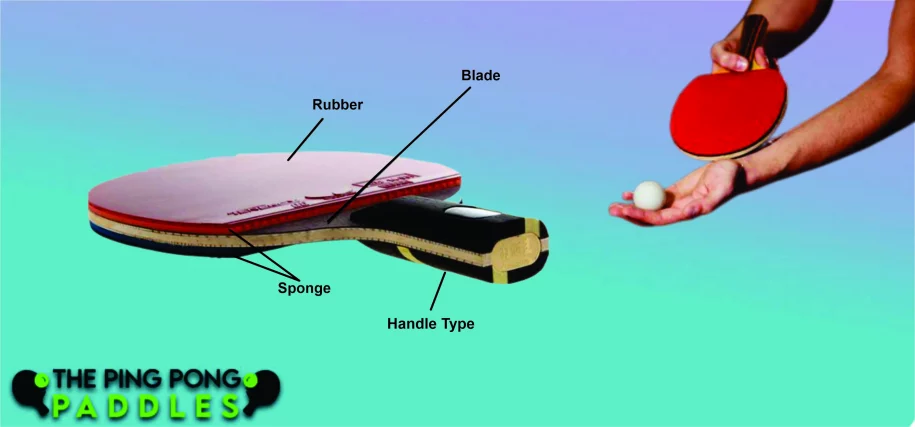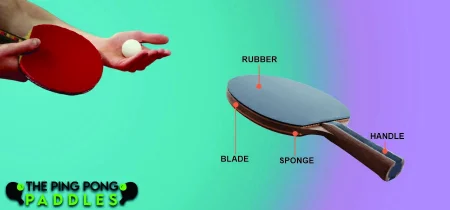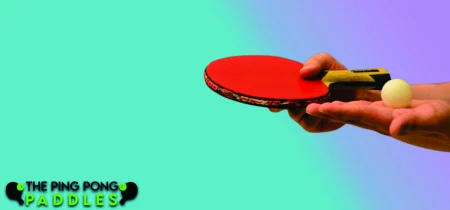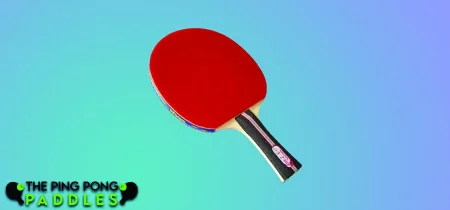How To Play & Choose Ping Pong Paddles
Introduction:
It’s a game of inches and modifications when it comes to Ping Pong. How To Play & Choose Best Ping Pong Paddles to adjust to their opponents’ style and spin. Even the most inexperienced players soon learn to adjust their placement and approach to counter their opponent’s preferred shots. How To Play & Choose Ping Pong Paddles we progress as players, we establish our favored grips, playstyles, favorite serves, and shot types.
There is an infinite amount of variability, and every player, even at the highest level of ping pong, has their distinct style seems to reason, then, that Ping Pong equipment is extremely adaptable. There is an almost infinite variety of paddles to maximize your game after you get past the typical “hard paddle” of rec rooms and basements. Most players may switch paddles a few times as they grow in the sport, figuring out which paddle best matches their game or which paddle best helps them improve while practicing.
When it comes to customizing your paddle, all of the options for the blade, grip, and rubber might be intimidating. We’re here to assist you! We have written on several Ready-To-Go (RTG) paddles based on the most prevalent play styles to assist you in finding the perfect paddle for your game. Continue reading for our paddle buying guide.
History of Ping Pong Paddle Color Difference:

There’s a reason why ping pong paddles come in two distinct colors on each side. It all started when ping pong clubs started holding contests. At these tournaments, players would turn up and breach the rules.
They did this to prevent players from gaining an edge over their opponents by having two separate advanced specialized rubber sheets with highly different playing qualities, or rubber sheets of the same type with one side changed.
Nowadays, ping pong paddles are inspected to ensure that they are constructed correctly and do not violate any restrictions. This avoids cheating and tremendously aids the game.
Paddle Basics:

Six basic parts make up a paddle. The handle, blade, forehand sponge and rubber, and backhand sponge and rubber are all included. Each of those components may be combined to produce a paddle that is tailored to your playing style. Let’s go through how to choose the finest paddle for you!
Step 1 – Grip:

The Shakehand grip is used by the great majority of players. However, some players, particularly in Asia, continue to use the Penhold grip. You should choose a handle that fits your grip type. Our RTG paddles have a Flared or Straight handle and are suited for Shakehand players.
To suit your preferences, choose between a Flared or Straight handle. In general, the Flared handle is more comfortable for players who grasp the paddle loosely, whereas the Straight handle is a little thinner and more suited to players who grip the paddle tightly.
Step 2 – Playstyle:
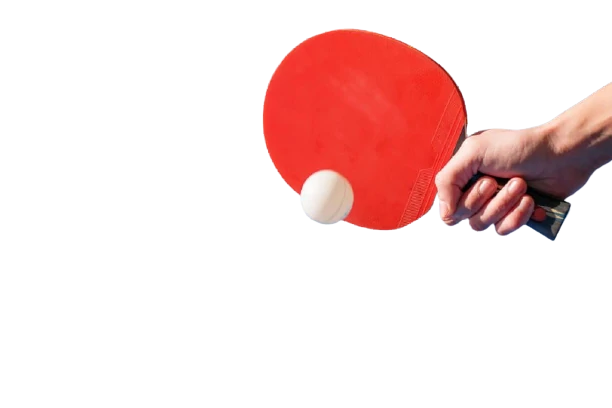
Paddles are, in the end, a highly personal choice. Every player has their style and swing, however, some paddles are better suited to certain playstyles. So, how do you go about playing? Are you a powerful shooter who likes to attack? A defensive player who beats opponents with positioning, patience, and guile?
Or do you place a premium on control, methodically placing your shots and shifting your opponent from side to side? Play a few games to get a sense of your gaming style and preferences. Alternatively, have a friend, coach, or opponent observe you play and provide feedback on your preferences and habits.
Step 3 – Picking a Blade:
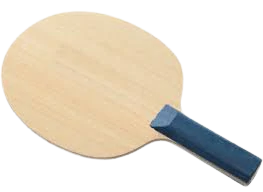
The blade is the most substantial portion of your paddle, and it determines the power rating the most. Paddles composed of lighter, more rigid materials are more attacking, whereas paddles made of softer materials are more defensive. You’ll want a blade with 5 or more layers of material if you prefer to play a fast-paced game.
The lighter the better, thus blades made of rigid-but-light carbon fiber or titanium carbon are ideal for your style of play all-wood blade is great for defensive players since it absorbs part of the ball’s energy and helps slow the game down to your liking.
Step 4 – Picking your Rubber:

Tackiness and stiffness are two characteristics that are commonly used to evaluate rubbers. The more tackiness there is, the more spin there is. More spin is usually produced by a softer rubber.So, if you want to play a slow, defensive game, a soft, sticky rubber is the way to go. You’ll want a firmer rubber if you play an aggressive game.
Step 5 – Picking your Sponge:

Between your rubber and the blade is a layer called a sponge. They are generally categorized as thick, medium, or thin. A paddle with a thick sponge (2.0 mm or more) is typically speedier and more aggressive. The thinner sponge is preferred by defensive athletes. When it comes to picking a best paddle, even following that step-by-step procedure may leave you feeling a little overwhelmed.
Thankfully, Biba and our product team have created a few paddles that are suitable for players who are still learning the game and seeking the right paddle. These are pre-assembled, long-lasting paddles suitable for a variety of playing styles. There are two versions for each type of play, with the more expensive version made of higher-quality materials that add some intricacy for a highly talented player.
If you’re a beginner, start with the entry-level choice. If you enjoy it and believe it has aided your game, try the following one when it’s time to replace it. We’re thrilled to have you join our squad and see you develop as a player!
Ping Pong Grips: How To Hold A Paddle? Penhold and Shakehand
The way you hold a ping pong paddle, much like any other sport, has an impact on the quality of your game performance. During a game of ping pong, mastering the body mechanics of your ping pong grip enhances your accuracy, control, and ability to produce spin.
Experts and coaches propose several different grips, each of which is best suited to certain sports and playing styles.
Why it’s important to choose the right grip
Ping pong is a game of speed and split-second decisions, so you must train your body to adjust intuitively and analyze your grip with each stroke. Your game will become more intuitive as you react spontaneously to diverse events. As a result, it’s critical to select and practice the appropriate grip as soon as feasible.
Once you’ve formed poor body mechanics and undesirable habits, it’s tough to retrain your body. When you alter your grip or learn a new one, it’s common for your game to suffer at first, which can discourage some people and further entrench poor habits.
While there is no one-size-fits-all grip for every player and playing style, the appropriate grip will provide you the control and accuracy you need when attacking and defending, as well as the split-second reactivity you’ll need to play successfully.
Different types of ping pong grips:
The Shakehand Grip:

The Shakehand Grip is named for the hand stance, which is quite similar to shaking hands. It’s a common grip in Western countries, and it’s gaining popularity among Asian players as well.
In the typical shakehand grip, the player wraps three fingers around the blade, with their index finger contacting the rubber’s edge and the blade’s edge tucked into the crease between their thumb and index finger.
The blade’s edge must be positioned within the natural V of the hand for wrist flexibility and control.
The Shallow Shakehand:

The hand is positioned like in the shallow shake hands, but the thumb is softly curled on the blade. The shallow shakehand is a simple approach for novices to learn how to grip the ping pong paddle in a natural, relaxed manner.
Pros
- On the other hand, it feels natural and comfortable.
- Wrist flexibility is excellent.
- It may be utilized on either the forehand or the backhand.
Cons
- The “crossover point” is the point at which a player must choose between a forehand and a backhand stroke. In a game, delays in this choice can be critical).
The Deep Shakehand:

The hand is held in the deep shakehand grip as described above, but the thumb is slightly lifted and rests on the bat’s rubber. Beginners are frequently advised to begin with a deep shakehand grip.
Pros
- On the other hand, it feels natural and comfortable.
- It may be utilized on either the forehand or the backhand.
- Enhances the strength and accuracy of assaults.
Cons
- The deep shakehand trades the shallow shakehand’s wrist flexibility for the higher power that comes with a solid wrist.
- The crossover point is shaky.
The Penhold grip:

The Penhold Grip gets its name from the fact that the paddle is gripped with the blade facing up and the paddle surface pointing down, just like a pen. It’s the most preferred grip among Asian Ping Pong players, and it’s also catching on in the West.
The blade edge is tucked into the V of the hand, between the thumb and fingers, and the index fingers and thumb are wrapped around the blade, resting on the rubber in the basic penhold grip. Penhold grips are divided into three categories.
The Chinese Penhold:
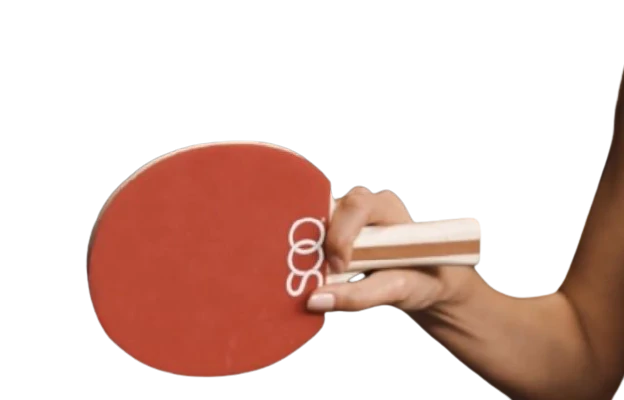
The blade is held downward in the Chinese Penhold, with the index finger and thumb wrapped around it as described above. On the opposite side, the three fingers of the hand are softly curled along the rubber.
Pros
- For both forehand and backhand strokes, this grip uses the same paddle side, depending on lateral wrist movement rather than flipping from side to side.
- This reduces the shakehand grip’s vulnerability at the crossover point.
- For imparting spin, you’ll need a wrist with a lot of flexibility.
- Both offensively and defensively versatile.
Cons
- Backhand topspin is difficult to achieve.
- Playing with the elbow lifted and the wrist rotated is physically exhausting, reducing endurance throughout a game.
How Do I Choose the Right Ping Pong Paddle for My Playstyle?
Ping pong, often known as Ping Pong, is more than simply a pleasant game to enjoy at your local leisure center. Every year, more than 10 million individuals compete in sanctioned Ping Pong competitions throughout the world.
You must practice and play hard to play a good game of ping pong. You must also ensure that you are utilizing the greatest table tennis equipment available. But how can you know whether you’re using the correct ping pong paddle for the job?
How to choose the right Ping Pong paddle?
The six essential components of a ping pong paddle are the forehand sponge and rubber, the backhand sponge and rubber, the blade, and the gripping in general.
The paddle’s core is made up of customizable components that will complement your gameplay style. Keep the following factors in mind while shopping for ping pong paddles in the future:
Grip: The Ping Pong Paddle grip is extremely crucial. A Shakehand grip is used by many players, whereas a Penhold grip is preferred by others. Shakehand is a grip in which the paddle is held as if shaking hands, whereas Penhold is a grip in which the paddle is held below the hand (almost as if one is using chopsticks).
The type of handle you want may be determined by how you hold your racket. For example, if you prefer a strong grip, a straight handle may be more comfortable, a flared handle may assist keep the racket in place even with a looser grip, and most penhold players prefer a shorter handle since they only grab the handle towards the top.
Playstyle: The sort of paddle you should use is directly related to how you play Ping Pong. For example, if you favor a defensive playstyle that relies on stronger control and placement to defeat your opponent, a paddle-like the Butterfly 401 would be a good fit. The Butterfly Balsa Carbo X5-FL may be closer to your preference if you’re a more offensive player who likes long shots. Paddles come in a variety of shapes and sizes, much like player styles.
Blade: The core of your paddle is the blade, which determines power, control, and feel. The blades are constructed from a variety of wood layers, which are frequently combined with carbon or other synthetic fibers. The weight of blades varies widely, and the parameters may be tailored to your playing style.
Rubber: Spin and power are most affected by the rubber of the paddle. When the ball is struck, the rubber and the sponge work together to alter it. Some players may concentrate on ball speed and trajectory, while others will concentrate on spin and control.
What Goes Into Ping Pong Paddle Rubber?
Ping pong paddle rubber is a topic that few newcomers are familiar with. To begin with, Ping Pong has a regulation that you must always have two distinct colored rubbers.
They must also be red and black if you’re playing in a standardized match. You may only pick from a limited number of rubber-producing brands for your paddle. There are a few more factors to consider when choosing your rubber, and you should make your decision based on your playing style:
- Paddle Sponge varies depending on the make of the paddle. The thickness is the major factor that determines how well you play. If you’re a more aggressive offensive player, go with a 2.0mm or higher rubber, and if you’re a better defensive player, go with a thinner rubber, anything below 2mm.
- The shape of your rubber’s pimples also matters. For example, a paddle with lengthy pimples is better for defensive play, whereas a paddle with short pimples is better for aggressive play.
- You should use reverse rubbers for your ping pong paddles if you are new to Ping Pong and want to get the feel of it. You’ll be able to flip it around as you see fit and acquire a feel for each type of rubber (with 4 sides to choose from).
Official Rules of Ping Pong Paddle:
- Games are played to 11 points
- Alternate serves every two points
- Toss the ball straight up when serving
- The serve can land anywhere in singles
- Doubles serves must go right court to the right court
- A serve that touches the net on the way over is a “let”
- Alternate hitting in a doubles rally
- Volleys are not allowed
- If your hit bounces back over the net by itself it is your point
- Touching the ball with your paddle hand is allowed
- You may not touch the table with your non-paddle hand
- An “edge” ball bouncing off the horizontal tabletop surface is good
- The honor system applies to disagreements
1: Games are played to 11 points:
A game is played to a maximum of 11 points. A game must be won by a margin of at least two points. In most cases, a match consists of the best three of five games.
2: Alternate serves every two points:
Two points are served at a time by either side of the table. EXCEPTION: When the score is tied 10-10 (“deuce”), service is alternated at each point. In ping pong, can you lose a serve? Yes! Serving on Game Point is not subject to any special rules.
3: Toss the ball straight up when serving:
In ping pong, how do you serve the ball? Hold the ball in your open hand and place it behind your table’s end. Toss a 6” straight up and down, striking it on the way down. It must first strike your side of the table, then the opposite side. NOTE: Once the ball leaves the server’s hand, it is in play, and if the ball is missed or mis-hit, it counts as the receiver’s point.
4: The serve can land anywhere in singles:
There are no constraints on where the ball can fall on your or your opponent’s side of the table. It can bounce twice or more on your enemy’s court (if so, that’s your point), bounce over the side, or even strike the edge.
5: Doubles serves must go right court to the right court:
The serve must land in both the server’s and the receiver’s respective courts (NOTE: landing on the centerline is fair). Doubles players switch places after their team has served twice.
6: A serve that touches the net on the way over is a “let”:
In ping pong, can the ball strike the net? Yes, if it reaches the top of the net and lands as a valid hit during a RALLY. But not when you’re on duty. A “let” serve occurs when a served ball contacts the net on its way over but otherwise lawfully bounces in play. There is no limit to the number of times this can occur.
7: Alternate hitting in a doubles rally:
In a rally, doubles players must alternate hitting balls, regardless of where the ball falls on the table.
8: Volleys are not allowed:
In ping pong, can you strike the ball before it bounces? No. You can “volley” the ball in traditional tennis (hitting the ball before it bounces on your side of the net). In Ping Pong, though, this results in a point for your opponent. NOTE: You still have a point if your opponent smashes a ball over your end of the table without hitting it and subsequently impacts you or your paddle.
9: If your hit bounces back over the net by itself it is your point:
If you hit the ball in a rally or on a serve and it bounces back over the net after striking your opponent’s side of the table, that is your point (owing to excessive spin).
10: Touching the ball with your paddle hand is allowed:
During a ping pong match, what happens if the ball strikes your finger or hand? There is no rule infringement if the ball reaches your PADDLE hand and otherwise results in a valid hit; play will proceed as usual. All fingers and the hand region below the wrist are included in your paddle hand.
But what if the ball lands somewhere else on a player’s body during a ping pong rally? For any reason, you may not contact the ball with your non-paddle hand. Your opponent will gain a point as a consequence. Your point is still valid if your opponent’s hit flies over your side of the table without impacting it and hit any part of you or your paddle.
11: You may not touch the table with your non-paddle hand:
You may make contact with the ball or the table, as well as other parts of your body, with your paddle hand (for example, when reaching in to return a short serve). NOTE: If the table moves at all as a consequence of your touch during a rally, it is your opponent’s point.
12: An “edge” ball bouncing off the horizontal tabletop surface is good:
Even if a serve or hit bounces diagonally, it may contact the top edge of the horizontal tabletop surface and be counted as valid. The permitted playing surface excludes the table’s vertical sides.
13: The honor system applies to disagreements:
When there is no referee present during a game and the players dispute on a call, the “honor system” applies, and the players must either agree or play the point over. Ping pong has a reputation for strong yet fair competition. Assist us in keeping it that way!
Frequently Asked Questions
Which Side of the Paddle Is Best For What?
Playing ping pong with each side doing a different role will help you enhance your ping pong skills dramatically. We’ve discussed how the red and black sides of the paddle represent distinct things earlier. On the other hand, you have total control over the suggestions they make.
For example, the black rubber on one side of your paddle may be designed for ball spin, while the red rubber on the other side is designed for power and speed. When it comes to putting your paddle together, you’ll have to make a few key decisions. It’s crucial to know which side represents which idea. Traditionally, you would use the red side of your paddle to assault your opponent.
What is Secret Ping Pong Color Configuration Tip?
In ping pong, a little-known fact is that playing with your offensive hand as black is advantageous. Because of the rubbers’ invention, several pros employ this arrangement. Because they lack the die that red rubbers have, black rubbers are said to be a little faster. This implies that you should set up your paddle such that the red side is utilized for spinning the ball, as red rubbers are thought to be superior for this. However, it is ultimately up to you, and there is no significant difference either way!
What Goes Into Ping Pong Paddle Rubber?
Ping pong paddle rubber is a topic that few newcomers are familiar with. To begin with, Ping Pong has a regulation that you must always have two distinct colored rubbers. They must also be red and black if you’re playing in a standardized match. You may only pick from a limited number of rubber-producing brands for your paddle.
Is There an Advantage to Using The Red or Black Side?
Ping pong paddles with various colors on either side usually provide each side a competitive edge. The black side, for example, may allow for less spin than the red side, and vice versa. This allows players to return the ball in a certain manner by flipping the paddle. Players are even permitted to check their opponents’ paddles to determine what type of spins they’re utilizing, according to ping pong rules.
Which Side Does What For a Ping Pong Paddle?
While this isn’t always the case, the red side of the ping pong ball usually causes it to go quicker. The black side is noted for imparting more spin to the ball. However, you may frequently purchase your rubbers to use with your paddle. In this manner, you may pick which side will be utilized for whatever purpose. Finally, wear a shirt that matches the color of the side of the paddle with which you return the ball. This might perplex your opponent and make it tough for him to see.
Do ping pong paddles make a difference?
The shape of a paddle will determine how much control you have over the ball. Control, spin, and speed are frequently traded off: the more control you have, the less speed and spin you can generate. A novice should opt for a high control grade, and as they advance, they may add more speed and spin.
What is the original name for ping pong?
The game was first created in England in the early twentieth century and was initially known as Ping-Pong. When the ancient Ping-Pong Association, founded in 1902, was resurrected in 1921–22, the term Ping Pong was used.
Conclusion:
How To Play & Choose Ping Pong Paddles, that concludes our analysis of how to play ping pong and select ping pong paddles. In this article, we have attempted to highlight all of the important components of the game and explain how to select the best paddle; we have also discussed several types of grips. Beginners should begin with the deep shakehand, according to most experts.
How To Play & Choose Ping Pong Paddles a great, adaptable, forceful grip that’s also simple to master for novices. After mastering the shareholder, a skilled player can try out alternative grips to better their game based on their style and weaknesses. Each grip has its own set of benefits and is optimal for various sorts of games, so it’s worth trying out several grips to discover the one that works best for you.

